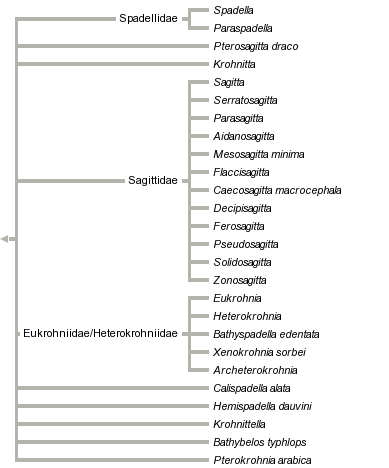Chaetognatha
Arrow Worms



This tree diagram shows the relationships between several groups of organisms.
The root of the current tree connects the organisms featured in this tree to their containing group and the rest of the Tree of Life. The basal branching point in the tree represents the ancestor of the other groups in the tree. This ancestor diversified over time into several descendent subgroups, which are represented as internal nodes and terminal taxa to the right.

You can click on the root to travel down the Tree of Life all the way to the root of all Life, and you can click on the names of descendent subgroups to travel up the Tree of Life all the way to individual species.
For more information on ToL tree formatting, please see Interpreting the Tree or Classification. To learn more about phylogenetic trees, please visit our Phylogenetic Biology pages.
close boxReferences
Bieri, R. 1991. Systematics of the Chaetognatha. Pages 122-136 in: The Biology of Chaetognaths. Q. Bone Q, H. Knapp, and A. C. Pierrot-Bults, eds. Oxford University Press, Oxford
Bone, Q., H. Knapp, and A. C. Pierrot-Bults, eds. 1991. The Biology of Chaetognaths. Oxford University Press, Oxford.
Casanova, J.-P. 1985. Description de l'appareil génital primitif du genre Heterokrohnia et nouvelle classification des Chaetognathes. Compte-rendus hebdomadaires des Séances de l'Academie des Sciences, Paris, Ser. 3, 301:397-402.
Chen, J.-Y. and D.-Y. Huang. 2002. A possible Lower Cambrian chaetognath (arrow worm). Science 298:187.
Halanych, K. M. 1996. Testing hypotheses of chaetognath origins: long branches revealed by 18S ribosomal DNA. Systematic Biology 45:223–246.
Helfenbein, K. G., H. M. Fourcade, R. G. Vanjani, and J. L. Boore. 2004. The mitochondrial genome of Paraspadella gotoi is highly reduced and reveals that chaetognaths are a sister group to protostomes. Proceedings of the National Academy of Sciences 101(29):10639-10643.
Kapp, H. The unique embryology of Chaetognatha. Zoologischer Anzeiger 239:263-266.
Papillon, D., Y. Perez, X. Caubit, and Y. Le Parco. 2006. Systematics of Chaetognatha under the light of molecular data, using duplicated ribosomal 18S DNA sequences. Molecular Phylogenetics and Evolution 38(3):621-634.
Salvini-Plawen, L. W. 1986. Systematics notes on Spadella and on the Chaetognatha in general. Z. Zool. Syst. Evol. 24:122–128.
Shinn, G. L. and M. E. Roberts. 1994. Ultrastructure of hatching chaetognaths (Ferosagitta hispida): phylogenetic implications. Journal of Morphology 219:143-163.
Tokioka, T. 1965. The taxonomical outline of Chaetognatha. Publications of the Seto Marine Biological Laboratory 12:335-357.
Telford, M. J. 2004. Affinity for arrow worms. Nature 431:254-256.
Telford, M. J., and P. W. H. Holland. 1993. The phylogenetic affinities of the chaetognaths: A molecular analysis. Molecular Biology and Evolution 10:660-676.
Telford, M. J. and P. W. H. Holland. 1997. Evolution of 28S ribosomal DNA in chaetognaths: duplicate genes and molecular phylogeny. Journal of Molecular Evolution 44:135-144.
Information on the Internet
- Chaetognatha. Erik V. Thuesen, Evergreen State College, Olympia, Washington.
- Chaetognatha of the World. A. Pierrot-Bults, Zoological Museum, University of Amsterdam.
- The Chaetognath, a strange creature. Micscape magazine article by Jean-Marie Cavanihac.
- A bioluminescent chaetognath. S. H. D. Haddock and J. F. Case
Title Illustrations
| Scientific Name | Spadella |
|---|---|
| Creator | J. M. Cavanihac |
| Copyright | © BIODIDAC |







